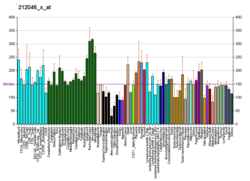ERT2
gene da espécie Homo sapiens
ERT2, também conhecida como p44MAPK, MAPK3 e ERK1, é uma enzima que em humanos é codificada pelo gene MAPK3.[3]
Ela é um membro da superfamília de proteína quinase, família de proteína cinase CMGC Ser/Thr, subfamília de MAP quinase. ERT2 é um apelido para o gene, proteína quinase 3 (ativada por mitógeno), em seres humanos.[4][5] Os pesquisadores fundiram a enzima a ERT2, em seguida ativaram o complexo com um análogo de tamoxifeno, 4-hidroxitamoxifeno, no caso de Cas9, a fim de colocar os controles no sistema CRISPR/Cas9.[6].
Interações
editarMAPK3 demonstrou interagir com:
Leitura adicional
editar- Peruzzi F, Gordon J, Darbinian N, Amini S (2002). «Tat-induced deregulation of neuronal differentiation and survival by nerve growth factor pathway». J. Neurovirol. 8 Suppl 2 (2): 91–6. PMID 12491158. doi:10.1080/13550280290167885
- Meloche S, Pouysségur J (2007). «The ERK1/2 mitogen-activated protein kinase pathway as a master regulator of the G1- to S-phase transition». Oncogene. 26 (22): 3227–39. PMID 17496918. doi:10.1038/sj.onc.1210414
- Ruscica M, Dozio E, Motta M, Magni P (2007), «Modulatory Actions of Neuropeptide y on Prostate Cancer Growth: Role of MAP Kinase/ERK 1/2 Activatio», Modulatory actions of neuropeptide Y on prostate cancer growth: role of MAP kinase/ERK 1/2 activation, ISBN 978-0-387-69114-5, Advances In Experimental Medicine And Biology, 604, pp. 96–100, PMID 17695723, doi:10.1007/978-0-387-69116-9_7
Referências
editar- ↑ «Drogas que interagem fisicamente com mitogen-activated protein kinase 3 ver/editar referências no wikidata»
- ↑ «Human PubMed Reference:»
- ↑ Garcı́a, F.; Zalba, G.; Páez, G.; Encı́o, I.; de Miguel, C. (15 de maio de 1998). «Molecular Cloning and Characterization of the Human p44 Mitogen-Activated Protein Kinase Gene». Genomics (em inglês) (1): 69–78. ISSN 0888-7543. doi:10.1006/geno.1998.5315. Consultado em 30 de junho de 2021
- ↑ Anti-ERT2 Antibody Products from Bio-Rad Antibodies publicado por "Biocompare"
- ↑ From Gene Targeting to Genome Editing: Transgenic animals applications and beyond por Mauricio Rocha-Martins et al, publicado pela An. Acad. Bras. Ciênc. vol.87 no.2 supl.0 Rio de Janeiro Aug. 2015 ISSN 1678-2690
- ↑ Toggling CRISPR Activity with a Chemical Switch Researchers design a Cas9 enzyme that cuts DNA only in the presence of particular drug. por Kerry Grens (2016)
- ↑ Todd JL, Tanner KG, Denu JM (maio de 1999). «Extracellular regulated kinases (ERK) 1 and ERK2 are authentic substrates for the dual-specificity protein-tyrosine phosphatase VHR. A novel role in down-regulating the ERK pathway». J. Biol. Chem. 274 (19): 13271–80. PMID 10224087. doi:10.1074/jbc.274.19.13271
- ↑ Muda M, Theodosiou A, Gillieron C, Smith A, Chabert C, Camps M, Boschert U, Rodrigues N, Davies K, Ashworth A, Arkinstall S (abril de 1998). «The mitogen-activated protein kinase phosphatase-3 N-terminal noncatalytic region is responsible for tight substrate binding and enzymatic specificity». J. Biol. Chem. 273 (15): 9323–9. PMID 9535927. doi:10.1074/jbc.273.15.9323
- ↑ Kim DW, Cochran BH (fevereiro de 2000). «Extracellular signal-regulated kinase binds to TFII-I and regulates its activation of the c-fos promoter». Mol. Cell. Biol. 20 (4): 1140–8. PMC 85232 . PMID 10648599. doi:10.1128/mcb.20.4.1140-1148.2000
- ↑ Zhou X, Richon VM, Wang AH, Yang XJ, Rifkind RA, Marks PA (dezembro de 2000). «Histone deacetylase 4 associates with extracellular signal-regulated kinases 1 and 2, and its cellular localization is regulated by oncogenic Ras». Proc. Natl. Acad. Sci. U.S.A. 97 (26): 14329–33. PMC 18918 . PMID 11114188. doi:10.1073/pnas.250494697
- ↑ a b Marti A, Luo Z, Cunningham C, Ohta Y, Hartwig J, Stossel TP, Kyriakis JM, Avruch J (janeiro de 1997). «Actin-binding protein-280 binds the stress-activated protein kinase (SAPK) activator SEK-1 and is required for tumor necrosis factor-alpha activation of SAPK in melanoma cells». J. Biol. Chem. 272 (5): 2620–8. PMID 9006895. doi:10.1074/jbc.272.5.2620
- ↑ a b Butch ER, Guan KL (fevereiro de 1996). «Characterization of ERK1 activation site mutants and the effect on recognition by MEK1 and MEK2». J. Biol. Chem. 271 (8): 4230–5. PMID 8626767. doi:10.1074/jbc.271.8.4230
- ↑ Elion EA (setembro de 1998). «Routing MAP kinase cascades». Science. 281 (5383): 1625–6. PMID 9767029. doi:10.1126/science.281.5383.1625
- ↑ Yung Y, Yao Z, Hanoch T, Seger R (maio de 2000). «ERK1b, a 46-kDa ERK isoform that is differentially regulated by MEK». J. Biol. Chem. 275 (21): 15799–808. PMID 10748187. doi:10.1074/jbc.M910060199
- ↑ a b Zheng CF, Guan KL (novembro de 1993). «Properties of MEKs, the kinases that phosphorylate and activate the extracellular signal-regulated kinases». J. Biol. Chem. 268 (32): 23933–9. PMID 8226933
- ↑ Pettiford SM, Herbst R (fevereiro de 2000). «The MAP-kinase ERK2 is a specific substrate of the protein tyrosine phosphatase HePTP». Oncogene. 19 (7): 858–69. PMID 10702794. doi:10.1038/sj.onc.1203408
- ↑ Saxena M, Williams S, Taskén K, Mustelin T (setembro de 1999). «Crosstalk between cAMP-dependent kinase and MAP kinase through a protein tyrosine phosphatase». Nat. Cell Biol. 1 (5): 305–11. PMID 10559944. doi:10.1038/13024
- ↑ Saxena M, Williams S, Brockdorff J, Gilman J, Mustelin T (abril de 1999). «Inhibition of T cell signaling by mitogen-activated protein kinase-targeted hematopoietic tyrosine phosphatase (HePTP)». J. Biol. Chem. 274 (17): 11693–700. PMID 10206983. doi:10.1074/jbc.274.17.11693
- ↑ Roux PP, Richards SA, Blenis J (julho de 2003). «Phosphorylation of p90 ribosomal S6 kinase (RSK) regulates extracellular signal-regulated kinase docking and RSK activity». Mol. Cell. Biol. 23 (14): 4796–804. PMC 162206 . PMID 12832467. doi:10.1128/mcb.23.14.4796-4804.2003
- ↑ Zhao Y, Bjorbaek C, Moller DE (novembro de 1996). «Regulation and interaction of pp90(rsk) isoforms with mitogen-activated protein kinases». J. Biol. Chem. 271 (47): 29773–9. PMID 8939914. doi:10.1074/jbc.271.47.29773
- ↑ Mao C, Ray-Gallet D, Tavitian A, Moreau-Gachelin F (fevereiro de 1996). «Differential phosphorylations of Spi-B and Spi-1 transcription factors». Oncogene. 12 (4): 863–73. PMID 8632909
